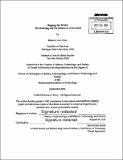Rigging the world : 3D modeling and the seduction of the real
Author(s)
Perry, Rebecca Ann
DownloadFull printable version (24.25Mb)
Alternative title
3D modeling and the seduction of the real
Other Contributors
Massachusetts Institute of Technology. Program in Science, Technology and Society.
Advisor
Merritt Roe Smith.
Terms of use
Metadata
Show full item recordAbstract
Evidence from history, archaeology, and the social sciences suggests that making models of the world has anchored our understanding of it since the earliest days. From models of deities, dwellings and weapons to molecules and planetary systems, models have been tools for thinking and imagining, as well as planning and building. Though there are many possible definitions, a digital model is understood here essentially as a miniature virtual world-a distillation that captures the essence of some aspect of the larger physical or imagined world-which provides a vehicle for virtual exploration or manipulation of that world, and a focal point for debates about its nature. This dissertation explores the communities engaged in making 3D digital models used in computer animation-globally dispersed communities linked by their professional tools and practices and their shared use of algorithms to sculpt geometry in the spaces of the machine. My research builds on the work of historians of computing and computer-aided design as well as insights on objects and their meanings by scholars such as Sherry Turkle, Peter Galison and Loraine Daston. To this conversation I contribute a view of digital models as meaningful objects, both tactile and evocative, around which conversations on expertise, craft, nature and representation coalesce. I draw on the work of Merritt Roe Smith on the contributions of government funding to innovation, and David Kaiser's work on the role of representations in circulating professional identities and shaping professional communities. Finally I draw on the work of those who have thought deeply about creativity and digital design tools and practices, including Rudolph Arnheim and Malcolm McCullough. I have also benefitted from Lev Manovich's work on software in the evolving field of digital humanities and software studies. I base my understanding of 3D modeling practices on a series of interviews conducted with a widely-dispersed community of artists, programmers and technical specialists who collaborate, sometimes over great distances, in creating 3D models for the entertainment industry. I argue that the idea of 3D modeling was shaped by the intersections of contrasting styles of abstraction practiced by artists and engineers. The interactions of present-day modelers with their models are part of an emerging discourse with the world, opening new possibilities for human interaction with the world's objects. As an example of the complex, global flow of people, objects and ideas I contrast two animation studios on opposite sides of the world, located in Connecticut and New Zealand. Though each of these is far from Hollywood-traditionally regarded as the heart of the film and animation industries-3D modeling practices, shared software and migrating workers link them to each other and to a global community of 3D thinkers and makers. Digital 3D modeling-sculpting characters, objects and environments, and even 3D printing the objects-emerges as a powerful way of connecting the self to the world. Finally, I examine the use of models as archives of real world objects and their attributes, with a case study a natural history museum's 3D modeling of a dinosaur.
Description
Thesis: Ph. D. in History, Anthropology, and Science, Technology and Society (HASTS), Massachusetts Institute of Technology, Program in Science, Technology and Society, 2014. Cataloged from PDF version of thesis. Includes bibliographical references (pages 260-266).
Date issued
2014Department
Massachusetts Institute of Technology. Program in Science, Technology and SocietyPublisher
Massachusetts Institute of Technology
Keywords
Program in Science, Technology and Society.